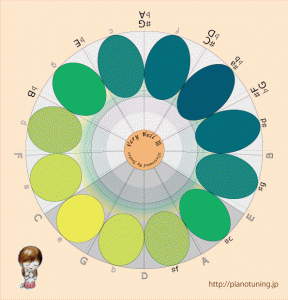 I am a piano tuner, Yoshio Okamoto, from Nishiwaki, Hyogo, JAPAN.
I am a piano tuner, Yoshio Okamoto, from Nishiwaki, Hyogo, JAPAN.
Thank you for visiting this site.
From days of Bach and before that, many methods of tuning the keyboard instruments have been experimented up till today. Could it be “a mischief of God”? None of the diatonic scale has been successfully constructed by pure 5th and pure 3rd without a howling(beats). Even more, if it comes to 12 keys of the keyboard…
Let’s look at some tuning systems created in the past.
Pythagorean system: tones of the scale derive from the intervals of pure 5th.
This makes a strong howling(many beats)on major 3rd.
Mean-tone system: constructed on pure 3rd. This makes the 5th narrow, not pure.
If these systems are applied on 12 tones of the keyboard, both systems would make intervals out of tune.
In these ways, the tuning of keyboard instruments is both the source of “trouble and joy” for ages.
The standard today is Equal Temperament, one of the great tuning system.
In this tuning, the octave is divided into twelve exactly equal semitones, so that an instrument sounds equally in any one of the twelve keys.
In contrast to “Equal Temperament” there are various “Classical Temperaments”.
Pythagorean scale: concept of pure 5th
Mean-tone system: presence of perfect 3rd, pure triads sound.
Well-Temperament: The tuning system which was invented around 300 years ago in the time of Bach, fits 24 keys comfortably. This includes WerkmeisterⅢ, KirnbergerⅢ, YoungⅡ,and recently found Bach’s Well-Temperament.
These are all well thought out. Every key has beauty in harmony, melody, and has own character.
From my experience, I understand that these “Classical Temperaments” definitely have important meanings especially in classis music.
For the European people, whose life is closely connected with church organ (tuned in classical temperament), the modality is a culture itself.
The effects of the classical temperaments are coming clear in classic music and even in modern music.
Many studies are done on classical temperaments. When I see these in famous publications and websites, I feel very excited.
I also would like to send out my message, from a point of view as a piano tuner: how I feel and what I have experienced.
I hope this could be some kind of a help to all the music lovers.
In this site, I would like to introduce my experiment since 1983, when I started working as a piano tuner .
“An Attempt of Classical Temperament on Modern Piano”
“Tone Circle for Keyboard Instruments”
By visualizing on the graphs, it made me easy to study the characteristics and the differences of the temperaments.
I understand that my study is still incomplete. If you have noticed any mistakes, please let me know. I am planning to update this site for new discoveries and also for corrections.
*Use of the graphs without permission is strictly prohibited.
*Personal use is welcomed. Please use the latest.
*For studies and thesis, please inform me. I am ready for a file to printout.
Chisako Murakami translated it into English from pianotuning.jp
Special thanks to Ms. Midori Kita.